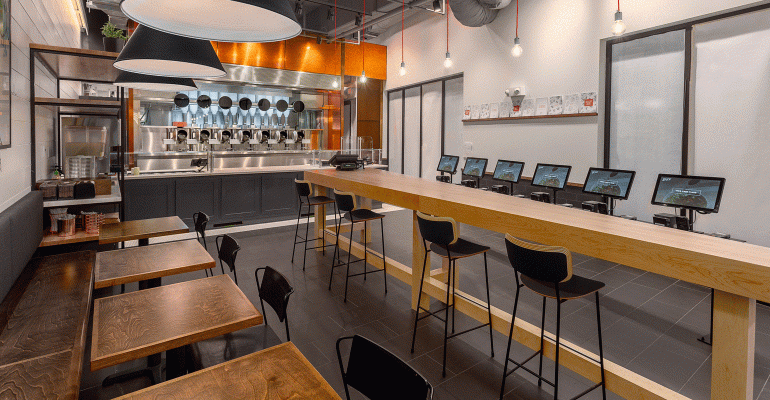When Kale Rogers was a broke college student attending the Massachusetts Institute of Technology, he was frequently on the hunt for “a healthy and delicious meal without paying $11 or $12.”
It was not an easy find. So Rogers and a group of fellow robotics students decided to leverage technology to make healthy, fast, delicious and affordable food. Their fast-casual restaurant, Spyce, opened in Boston in May with culinary guidance from the famed fine-dining chef Daniel Boulud.
 “Our idea all along was to look into the industry and find ways that we could make everything more efficient,” said Rogers, left, who is a co-founder of Spyce and the chief operating officer.
“Our idea all along was to look into the industry and find ways that we could make everything more efficient,” said Rogers, left, who is a co-founder of Spyce and the chief operating officer.
All bowls at Spyce are $7.50, and the recipes have been created by Boulud with Sam Benson, Spyce’s executive chef, who previously worked at Café Boulud and in culinary training at Chipotle Mexican Grill. All bowls — like the Thai bowl with roasted chicken, sweet potatoes, curry and star anise — are customizable.

A few years ago, when the concept was in its infancy, the Spyce team reached out to Boulud by guessing his email address.
“We had done some of the menu and development ourselves before and worked with some random freelance chefs, and we came up with an okay menu, but we understood that, at the end of the day, we had created technology that was extremely capable of cooking a wide variety of different cuisines, but we needed someone with better culinary talent,” said Rogers.
When Spyce showed Boulud a meal and the prototype, he was impressed. Boulud ended up becoming an investor and the culinary director, and he helped the team bring in Benson.

“It’s fabulous,” said Boulud. “It’s the beginning, but I think it has great potential in the future and is not about replacing people with this concept. It’s all about bringing service at the right price and quality, and food safety as well.”
While humans do the prep work in a commissary kitchen, when a customer orders through the restaurant’s self-service kiosks, the robots take over for most of the cooking. Containers holding various ingredients dispense to another container called a “runner,” which moves back and forth collecting all components of a recipe. The cooking wok receives the ingredients from the runner and cooks in a “tumbling fashion” for a consistent sauté.
“We cook using induction, so a really efficient, highly accurate form of cooking,” said Rogers. “We can monitor the temperature, and after we cook, then we plate, and our chef garde manger, which is like a cold prep chef in a French kitchen, will add the finishing touch.”
The garde manger is one of the ways that Spyce keeps the humanity and hospitality in the concept.

Executive chef Sam Benson and Daniel Boulud
“The finishing touch is always done by one of our awesome garde mangers, that allows them to focus on the presentation of the bowl, add that little personal touch, that little spark of creativity, and hand it to you with a smile. We also have dedicated guides in our restaurant. They’re there to ask you how your day is going and to answer any questions about the menu, to provide the front-of-house experience and that connection that I think is sometimes one of the first things you lose in these fast-casual type places,” said Rogers.
“What we really tried to do was make the business as efficient as possible in a way that we could save money and give that back to the guests,” he said, “but not take away one of some of the most important human elements of hospitality.”
Whether the concept is scaleable remains to be seen, said Rogers.
“We still have to analyze, but I’m very excited for the future,” he said. “I would love to grow and open more restaurants.”
Contact Gloria Dawson at [email protected]
Follow her on Twitter: @gloriadawson





